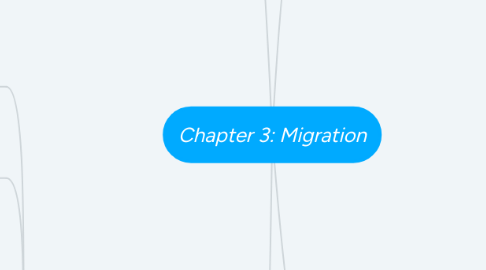
1. Key Question 3: Where do people migrate?
1.1. Global migration flows. Before 1500 global scale migration occurred haphazardly.
1.2. Regional migration flows
1.2.1. Reconnection of cultural groups.
1.2.1.1. Jewish people migrated back to Israel, reconnecting with those who never left.
1.2.2. Conflict and war force many people out of places and into others.
1.2.2.1. The Berlin Wall caused many people leave the soviet controlled east Germany.
1.2.3. Economic opportunities. Big cities where most of the jobs are are called islands of development.
1.2.3.1. In west Africa, oil producing areas are islands of development.
1.3. National migration flows can also be called internal migration flows. Within a country.
1.3.1. In the United States, people moved west.
1.3.2. Russification was performed by having native Russians move out of major cities and fill the rest of the country.
1.4. Guest workers are labor migrants. People who migrated to find jobs, that do labor.
1.5. Refugees
1.5.1. Regions of dislocation
1.5.1.1. North and Southwest Asia
1.5.1.1.1. Conflict in Afghanistan has lasted over thirty years, causing the biggest refugee flow today.
1.5.1.1.2. The gulf war dislocated the Kurdish people of Iraq
1.5.1.1.3. Soviet invasion of Afghanistan resulted in even more refugees
1.5.1.2. Africa
1.5.1.2.1. Millions of IDPs spread throughout the region. Political instability means that many people are moving around.
1.5.1.2.2. A genocide caused many non-arab Muslims in Darfur to flee
1.5.1.3. South Asia
1.5.1.3.1. Takes a lot of refugees from Afghanistan.
1.5.1.3.2. There is a civil war Sri-Lanka.
1.5.1.4. Southeast Asia
1.5.1.4.1. Refugees from Vietnam, and from natural disasters.
1.5.1.5. Europe
1.5.1.5.1. The collapse of Yugoslavia created a massive refugee crisis.
1.5.1.6. Other Regions
1.5.1.6.1. The only western country having trouble is Colombia, which has a severe IDP problem due to the country’s struggle against narcotics.
1.5.2. People can be displaced within their countries.
1.5.2.1. Hurricane Katrina displaced many people n the United States.
2. Key Question 4: How do governments affect migration?
2.1. Legal restrictions
2.1.1. Restrictive legislation in the United States happened in 1882 when congress designed immigration laws.
2.2. Post 9/11
2.2.1. Immigration now has more security measures.
2.2.2. Anyone who immigrated from where terrorist groups opperate were detained.
2.2.3. The government can detain any illegal immigrant
2.2.4. Certain groups are saying that shutting people out is only making people hate the United States, and promoting terrorism.
2.3. Waves of immigration in the U.S.
2.3.1. When the U.S. first opened its doors to the world, people migrated in from Europe.
2.3.2. After World War One, the U.S. started practicing isolationism.
2.3.3. The U.S. set immigration quotas, so European countries could immigrate 3% of the national poplulation of the United States. Congress later changed this number to 2%.
2.3.4. After 1940 the U.S. extended this to China and Japan.
2.3.5. In 1965 the quota system was abolished.
2.3.6. Many countries practice selective immigration in which certain people are denied from entering.
3. Key Question 1: What is Migration
3.1. Cyclic Movement is when a journey brings us back to our home. Shorter period of time away
3.1.1. Going to the grocery store
3.1.2. Going to school.
3.1.3. Our cyclic movements dictate our activity space.
3.1.4. Commuting
3.2. Period Movement is when you leave your home for an extended period of time, but still eventually come back.
3.2.1. Migrant labor
3.2.2. Following livestock or a food source as the seasons change
3.3. With migration, the person or people migrating will not return to their old home. They are headed to a new home.
4. Key Question 2: Why do People Migrate
4.1. Forced migration is when people are forced to move by authority or power
4.2. Push and pull factors in voluntary migration can be determined by Ravenstein’s laws of migration
4.2.1. Every migration flow generates a return or counter migration
4.2.2. The majority of migrants move a short distance
4.2.3. Migrants who move longer distances tend to choose big city destinations
4.2.4. Urban residents are less migratory than inhabitants of rural areas
4.2.5. Families are less likely to make international moves than young adults
4.3. Types of push and pull factors
4.3.1. Power relationships. Gender, ethnicity, race, and money are all part of decisions to migrate. When someone employs someone with a different anything from the examples above, a power relationship is established.
4.3.2. Legal Status. Migrants can enter a country legally, or illegally. Having a visa makes you a legal immigrant. If you don’t, you are an illegal immigrant and you will be deported.
4.3.3. Economic conditions. A major push factor is poverty. A pull factor is perceived economic opportunities.
4.4. Political circumstances
4.4.1. Oppressive regimes have often affected migration. For example, in 1975 hundreds of thousands of Vietnamese people fled their country because communists took control.
4.5. Armed conflict and war
4.5.1. Safety is a big concern, so many people migrate away from violence
4.5.2. In Yugoslavia war caused as many as three million people to emigrate.
4.6. Environmental conditions
4.6.1. When the environment is unlivable, people migrate.
4.6.2. In Ireland the potato blight forced many people to North America and Western Europe.
4.7. Culture and traditions
4.7.1. When people fear that their culture will not survive a major political transition, they migrate.
4.7.2. In the 1990s more than 2 million Jews migrated to Israel.
4.8. Technological advances
4.8.1. With modern transportation, migrating is much easier, giving more people the means to travel to new places very quickly.

